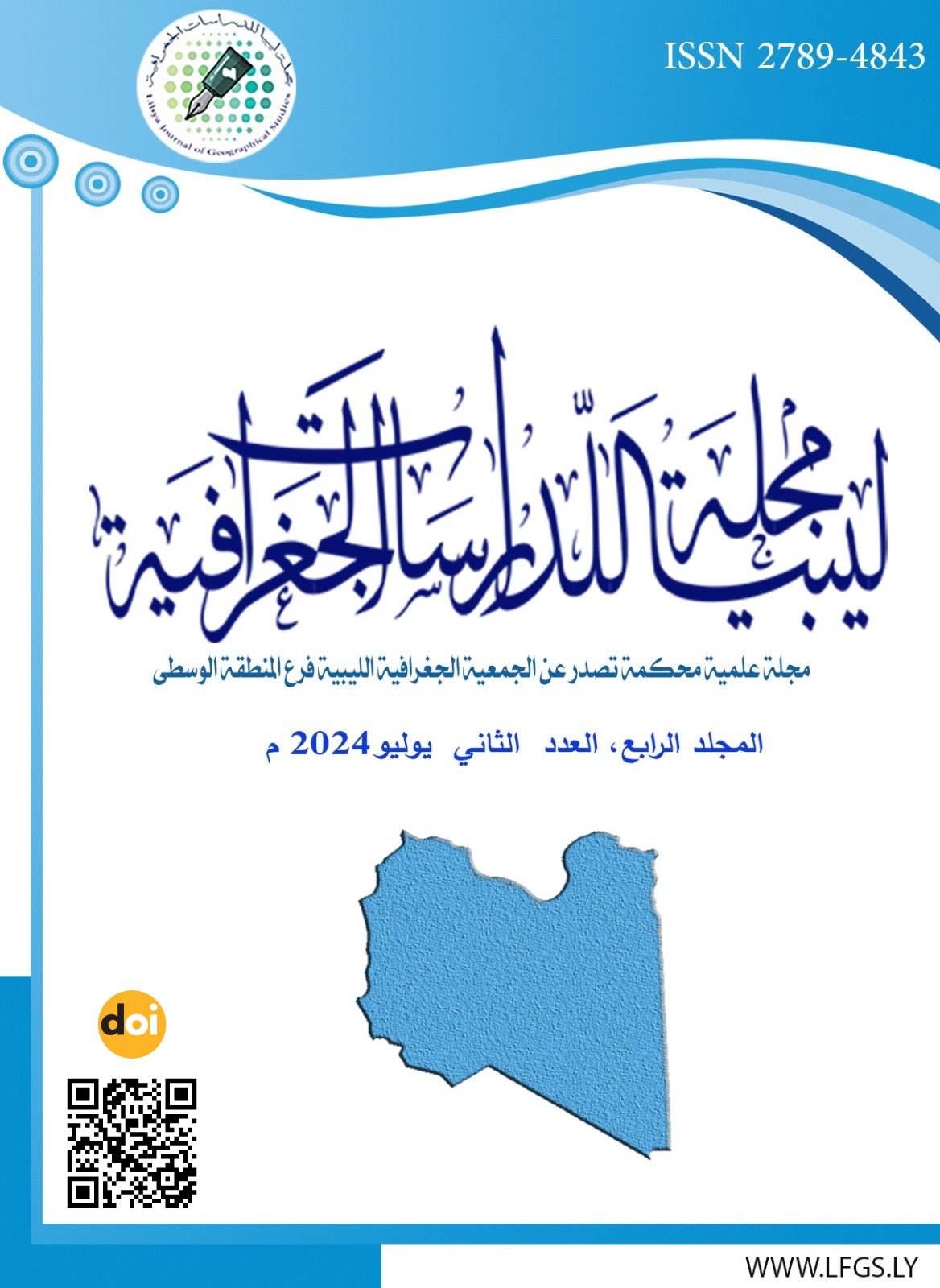Modeling population density in the city of Sebha using dasymetric maps
DOI:
https://doi.org/10.37375/jlgs.v4i2.2848Keywords:
Sebha, dasymetric mapping, population distribution, population density, remote sensing, supervised classificationAbstract
Studying the geographic distribution of the population is important. For its role in recognizing population distribution patterns and responding to urban needs and problems. Dasymetric maps provide accurate estimates of population distribution and highlight the variation in density within the areas of the administrative unit. Therefore, the study aims to identify the levels of population density in the city of Sebha using decimetric maps. The importance of the study lies in producing a dasymetric map that reflects the actual distribution of population in geographical space and highlights the variation of density within areas. Administrative unit. The study relied on the descriptive analytical approach, and we used the multi-category method to create a dasymetric map of population distribution, by modeling the data within a geographic information systems environment. The results showed that the density map of Sebha shows an accurate representation of population distribution, as it excluded uninhabited and non-residential areas, which represented 79% of the total area (2006 AD) and 62% (2022 AD), and density levels varied within neighborhoods depending on the housing type. It shows that the population distribution tends to spread horizontally across space. The estimated values of the city's dasymetric density were close to the actual values, which indicates the effectiveness of satellite visualization and GIS technology in producing decimeter density maps.
References
الكتب:
- أبو راضي، فتحي، (2001)، خرائط التوزيعات البشرية ورسومها البيانية، دار النهضة العربية للطباعة والنشر والتوزيع، بيروت، ط1.
- كلارك، جون، ترجمة: مكي، محمد شوقي إبراهيم، (1984)، جغرافية السكان، دار المريخ، الرياض.
- أبوعيانة، فتحي محمد، (1985)، دراسات في علم السكان، دار النهضة العربية، بيروت.
الدوريات العلمية والنشرات:
- جهاد، أحمد محمد، حمادي، أحمد سلمان، التصنيف الرقمي للفئات في خرائط الكثافة السكانية باستخدام GIS ، مجلة مداد الآداب، تصدر عن كلية الآداب الجامعة العراقية، العدد (13)، عدد خاص بالمؤتمرات، 2018-2019م.
- شخنوب، وفاء محمد عطية، مصادر بيانات الهجرة الداخلية في ليبيا، أعمال المؤتمر الجغرافي الثاني حول جغرافية ليبيا، جامعة بنغازي، كلية الآداب، قسم الجغرافيا، نوفمبر 2018م.
المصادر والوثائق الحكومية:
- أمانة اللجنة الشعبية العامة للاقتصاد والتخطيط،(1985م)، نتائج التعداد العام للسكان سنة 1984م، مصلحة الإحصاء والتعداد، طرابلس.
- أمانة اللجنة الشعبية العامة للتخطيط، مخطط الجيل الثالث، النطاق التخطيطي فزان 2005- 2025م، المكتب الاستشاري الهندسي للمرافق، تقرير غير منشور.
- أمانة اللجنة الشعبية العامة للمرافق، (1985م)، التقرير النهائي للمخطط الإقليمي، إقليم سبها، تقرير رقم س.ن1، شركة فنماب.
- مصلحة المساحة، (2005م)، خريطة ليبيا، الشركة المصرية للأعمال المساحية وإنتاج الخرائط، القاهرة.
- مصلحة التخطيط العمراني، المنطقة الجنوبية، (2022م)، بيانات غير منشورة.
- الهيئة العامة للمعلومات، (2008م)، نتائج التعداد العام للسكان سنة 2006م، مصلحة الاحصاء والتعداد، طرابلس.
المراجع الأجنبية:
- Alena, V., & Jan, K., (2013). Dasymetric mapping as an analytical tool for the city development identification and its cartographic visualization.
- Baynes, J., Neale, A., & Hultgren, T. (2022). Improving intelligent dasymetric mapping population density estimates at 30 m resolution for the conterminous United States by excluding uninhabited areas. Earth system science data, 14(6), 2833-2849
- Cartagena-Colón, M., Mattei, H., & Wang, C. (2022). Dasymetric Mapping of Population Using Land Cover Data in JBNERR, Puerto Rico during 1990–2010. Land, 11(12), 2301
- Eicher, C., & Brewer, C. (2001). Dasymetric mapping and areal interpolation: Implementation and evaluation. Cartography and Geographic Information Science, 28(2), 125-138.
- George, M., Preparing for Sustainable Urban Growth in Developing Regions. Meeting of the United Nations Group of Experts on Population Distribution, Urbanization, Internal Migration and Development, United Nations, New York, 21-23 January 2008, 47-72.
- Kim, H., & Choi, J. (2011). A hybrid dasymetric mapping for population density surface using remote sensing data. Journal of the Korean Geographical Society, 46(1), 67-80.
- Krunić, N., Bajat, B., Kilibarda, M., & Tošić, D. (2011). Modelling the spatial distribution of Vojvodina's population by using dasymetric method. Spatium, (24), 45-50.
- Liu, L., Peng, Z., Wu, H., Jiao, H., & Yu, Y. (2018). Exploring urban spatial feature with dasymetric mapping based on mobile phone data and LUR-2SFCAe method. Sustainability, 10(7), 2432.
- Mennis, J., & Hultgren, T. (2005, July). Dasymetric mapping for disaggregating coarse resolution population data. In Proceedings of the 22nd Annual International Cartographic Conference (pp. 9-16).
- Mennis, J., & Hultgren, T. (2006). Intelligent dasymetric mapping and its application to areal interpolation. Cartography and Geographic Information Science, 33(3), 179-194.
- Sleeter, R., & Gould, M. (2007). Geographic information system software to remodel population data using dasymetric mapping methods (Vol. 11). Denver, CO, USA: US Department of the Interior, US Geological Survey.














